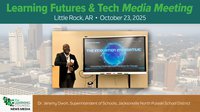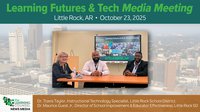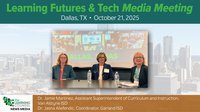(April 7, 2020)
Schools, Districts and companies selling to them have questions, and forebodings. There are two lines of thought:
- In the Fall, things will get back to normal. Then in about eighteen months, budget cuts are coming for K12 everywhere, with the exception of approximately $13.5 Billion coming in the new CARES Act stimulus. Another $7.5 Billion for governors to chose how to spend plus childcare assistance and Head Start, will smooth over some budget shortfalls in K12 in the neediest places.
- Normal is gone for good.
What’s important to look at are facts before the national quarantines started to tank the economy. These tell the trajectory that was already happening. We’ll list those below the early predictions. Once those are understood, then add the three other events in subsequent articles, which are 1) the behavior of parents during the quarantine weeks finding digital learning at an unprecedented level, with consumer Apps, sites, and switching to online schools, and school-led remote learning, 2) the economic aftermath, and 3) the probable behavior of districts who think only with methods of the past for cutting budgets, doing layoffs and consolidating or eliminating schools and programs. This is because true hybrid and uberized learning that dramatically shifts the structuring of human teaching and the use of physical spaces, is in its infancy and despite the monumental cost savings it would bring, far too few even understand it.
Early Predictions
Restrictions eased, fast-tracked educational alternatives
It’s predicted that the federal government and states will lift as many restrictions like seat-time as possible, and probably also waive other structural obligations that have plagued districts for a long time and pre-obligated budgeting by some 80 percent. States behind-the-scenes will continue to say one thing publicly while sliding in policies that offload the majority of work at a fraction of former cost onto non-traditional and/or non-public education alternatives. In this way, government will appear to respond to citizen desire for choice while being able to keep decades-old high pension and debt obligations payments because normal operating costs are halved or better. This has already been happening in many places, but of course spoken of publicly in other terms to satisfy the unions and public opinion.
Alarmist news about closings, layoffs
We can expect inefficient and underutilized schools to be closed quickly, possibly before the new school year in September. There will not be as many of these as there will seem to be early on because a lot of this has already happened. Other mass media will get word of teacher layoffs and school closings and sound the alarm to make it seem the world of education is coming to an end, when in fact some of those areas will have been due because of demographic shifts and attrition to alternatives well before this. In two years, though, there could be a cataclysm for education of epic proportions.
On the upside, we’ll still see newly overcrowded schools in emerging areas open new schools. Unfortunately, multi-million-dollar new construction during a time of great economic downturn and recovery could be seen highly unfavorable because other areas and people will be suffering.
Infighting
Expect unions to intensify their fight with online and charter schools, which parents are already shifting to in record numbers.
Accelerated layoffs
Here’s why we know layoffs will eventually be significant, but not necessarily reflective of a wholesale cataclysm. First, layoffs for the last year had started to sound like they were accelerating anyway, with quite a few news points before March 11th, 2020.
The Trajectory
2017 was the biggest layoff year on record, with many districts nationwide laying off staff and teachers. Layoffs continued in 2018 and throughout 2019. Stories abound of hundreds if not thousands laid off, so many districts entering the aftermath of the pandemic are already “at the bone” in terms of their usual structure of delivery.
Since December, here are more job eliminations leading up to the start of quarantine:
- Dec 4, 2019, RCSD layoff plan: 152 teachers, 32 non-teachers, 12 administrators and more Education (workers), WROC
- Dec 18, 2019, RCSD union negotiations hit snag, more layoffs likely at end of school year, WXXI News NY
- Feb. 6, 2020, East Bay School District Weighs Laying Off 250 Teachers, KQED News
- February 11, 2020, Contra Costa County, Teachers, Workers With East Bay School District Facing Layoffs, The West Contra Costa Unified School district is looking at a nearly $48 million budget shortfall, superintendent says, NBC Bay Area
- Feb. 21, 2020, Memo to San Francisco schools: Get ready for budget cuts and layoffs, SF Chronicle
- February 21, 2020, More teacher layoffs approved in Sacramento school district. How many will lose their jobs?, The Sacramento Bee
- Feb 28, 2020, Napa school board approves up to 145 teacher layoffs before 2020-21 year, Napa Valley Register
- March 10, 2020, Parents, community members and teachers learned last week that the district is considering eliminating 230 teachers starting July 1 to save $22 million, EdSource
- March 12, 2020, St. Paul Public Schools threatens layoffs if strike continues, CityPages News
- March 10, 2020, Sweetwater District teachers begin receiving pink slips, More than 200 teachers and librarians are expecting to receive pink slips by this Sunday, March 15, CBS 8 News
- March 11, 2020, St. Paul Public Schools Send Layoff Notices for Teaching Assistants, Workday MN
- March 11, 2020, Tam Union trustees approve provisional school layoffs, cuts. Marin Independent Journal
- March 12, 2019, Palmyra-Eagle school board votes to close Palmyra Elementary, approve layoff notices for 15 district teacher, JSOnline
- May 13, 2019, Hundreds protest budget cuts, planned teacher layoffs at Jersey City schools, NJ.com
- April 13, 2019, Spokane schools issues 325 layoff notices amid budget shortfall, Spokesman-Review
Why was this all happening even before the quarantines? Didn’t the economy pick up significantly in the last four years? Yes, the economy did, and taxation revenues created surpluses in many places, just not necessarily for education. If you really look at this on a national scale and start adding it up, it looks like an entire system in cascading failure.
Less children
According to a Sept. 25th, 2019 article by Debtwire, school districts nationwide struggle with declining enrollment. They cited, “The Los Angeles Unified School District (LAUSD) forecasts that enrollment will continue to decline to 536,202 in 2021-2022, from 621,188 students in the 2012-2013 school year, according to the district’s 2019-2020 budget. Enrollment in the district peaked in the 2002-2003 school year and has fallen every year since. The district attributes the decline to lower birth rates and a higher cost of living in southern California.”
However, Los Angeles County’s population is growing. The county added more than 423,000 people between 2010 and 2018, the article stated, “In addition, the county’s population is expected to grow through 2050.”
The same article stated that “Student enrollment at Philadelphia City School District is forecast to fall to 110,709 in the 2028-2029 school year, from 130,566 in 2018-2019, data from the Pennsylvania Department of Education show. Enrollment at the district has fallen by more than 24 percent in the past 10 years, despite a 3.8 percent increase in the general population, according to data from Pennsylvania Department of Education and the US Census Bureau.”
“The population structure of the country, in at least the last eight years, has shown a decline of the child population,” said demographer William Frey, a senior fellow at the Brookings Institute.
Among the nation's 381 metros, 214 showed losses in their child populations in 2018. “I think many school districts need to be prepared for slower growth or declines in their enrollments,” Frey said.
“Less children, thanks to a lower birth rate, may have some of its roots in the financial crisis, as millennials delayed having families because of tougher financial conditions,” Frey said.
Following the 2008 financial crisis, cities experienced a gain in migrants from other areas in the country, which was ‘very unusual,’ he said, but now, the trends have reversed, and more people are moving out to the suburbs or exurbs. Also, birthrates among immigrant populations have declined much faster than earlier predictions,” said Paul Warren, a research associate at the Public Policy Institute of California.
Lack of achievement driving choice
The last twenty years have not seen increasing academic achievement. On the contrary, national averages indicated significantly lowered achievement.
The inconvenient truth is the fact that the homeschooling/unschooling movement is now almost twice the size of the public charters, and together with the private school options is at 27 percent of the American landscape. These numbers are not reported accurately because twelve of the states do not even require parents to register that they will be homeschooling with any government entity. They are “off the grid.” In addition, the homeschooling/unschooling trend is now culturally “cool” and has been accelerating, growing at 20 percent annually.
Now that nearly every parent in America has been experiencing up to three weeks of homeschooling of one flavor or another, it’s a fairly easy assumption that the trend will grow. (More on this in another article.)
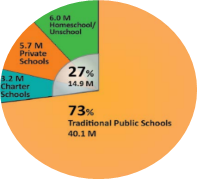
Spending growth
Over the last 30 years, spending has grown out of whack with both the economy and population growth. It doesn’t make sense to keep spending more per student when results are significantly down. This is the real crux of what will force changes many are not expecting. This data is taken from Statistica and the NCES data.
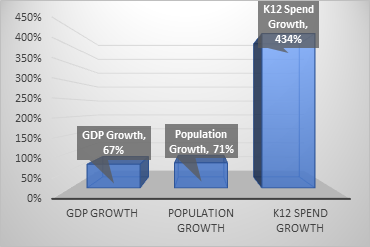
Digital first
There is no escaping the fact that the digital first entities are winning big during the quarantine. Amazon is winning at least 10:1 against physical retail. In fact, much of physical retail is mandated to be closed. The trend for the last ten years to use digital in schools has already caused a huge shift away from paper textbooks towards a far greater spend on digital resources. Digital anything is going to be a big winner post the quarantines and is already seeing huge jumps. Some software companies are reporting picking up over 1,000,000 users in a matter of days. Districts are complaining they can’t get enough chromebooks because so many tried to order tens of thousands at once.
Placeless
Placeless has been the trend in private industry for decades, and what is truly remarkable is that more than 50 percent of jobs are still functioning and have little risk of layoffs in the United States because so many companies were able to simply have all staff work from home. It’s the other 50 percent that are not functioning that’s the killer, and that includes many schools who simply shut down completely with no remote learning. While having no physical campuses is probably not a real solution because students want and need community, the idea that schools will remain the same with classrooms when all of industry has gotten rid of most office space in favor of cubicles and open space work, makes little sense.
Part of the placeless trajectory can be seen in the rise of “ghost cities” all across America and the world. As industrialization died, many cities saw a big increases in abandoned residential and retail properties, and vacancies. The pace of this had only slight relief in the last couple years, but more growth in exits to very rural areas and small-town America, either to retire or just get out of city life. Unlike their predecessor generations, millennials are leaving cities rather than rushing to them. Cities with more than a half million people collectively lost 27,000 people between the ages 25-39 in 2018. It was the 4th consecutive year for Chicago, New York, Houston, Las Vegas, San Francisco, Washington D.C. and Portland to lose more of the generation expected to produce children arriving in schools.
Since many of the millennial population can find work they can do from anywhere, they want communities of high value, low crime, low traffic, space to spare at low cost and great schools. On a national scale, then, the trend is towards American’s spreading out, whereas in the past with the industrial age the trend was towards larger and larger cities.
While there are other items to mention as to the trajectory before this emergency, they are not as significant. Things like what subjects and higher emphasis on career and technical education, plus all things STEM, having academic standards, trying to get less testing, teacher shortages and more will play their parts in what happens after.
Stay tuned for more as the situation unfolds.
About the author

LeiLani Cauthen is an everyday philosopher, author, speaker, research analyst and futurist. As CEO and Publisher of the Learning Counsel, a research and news media hub for K12 education, she produces leadership training events in twenty-five U.S. cities annually plus virtual discussion internet seminars. She is also the Founder of Knowstory, a new social media site just for education and the GrandMaster of the Edujedi Leadership Society.
***







